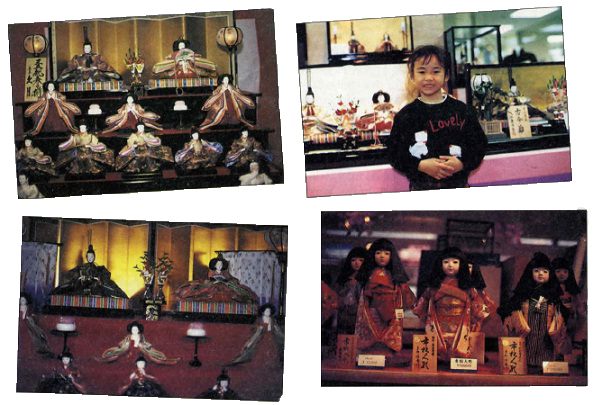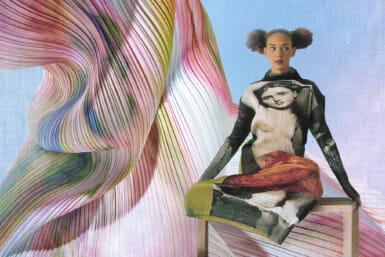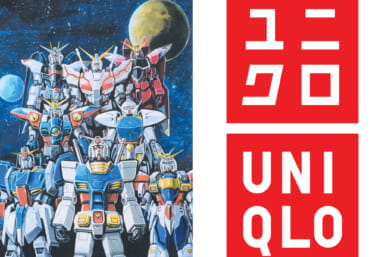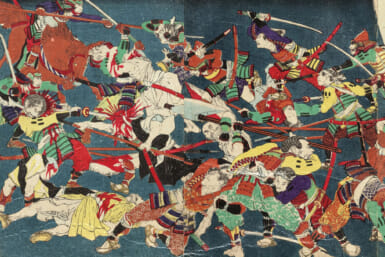The Dolls & Daydreams of Hina Matsuri
by Denny Sargent
Photos by Rebecca Sargent
As early as a month preceding Girls’ Day—Mar. 3—millions of royal “doll families” (hina ningyo) will be hauled from closets and shelves, dusted off and set up in places of honor. Often an ornate seven- or eight-tiered stand will first be erected, then the 15 clothed dolls, dressed in Heian Period opulence, will be carefully arranged on it in a prescribed manner.
The most important personages sit like the royalty they are on the top tier. They are the prince (Odairi-sama) and princess (Ohina-sama). When all the dolls are displayed and the last detail has been carefully adjusted, the girls, maidens and mothers of Japan will sit back and enjoy with pride this beautiful set of mystical dolls.
Long ago, dolls were serious magic in Japan, and though the once-powerful symbols and rituals have often lost their deep meaning, they still evoke strong feelings. Hina Matsuri or Girls’ Day is an ancient purification festival that originally came from China many centuries ago. It honors girls and young women and was practiced to magically encourage their health, beauty, marriage and prosperity.
An echo of this still lingers in certain parts of Japan where a special pair of dolls is often made out of paper by girls at this time. These nagashi bina dolls, again a “prince and a princess,” are then placed on a paper boat and sent sailing off into a stream, along with prayers for luck, health and happiness.
Another insight into the origin of Girls’ Day comes in the form of the ancient Shinto ritual called katashiro where small dolls are rubbed over the body to remove evil and are then disposed of!
Today, Hina Matsuri is not such a serious affair but is still one of the “Five Great Festivals” in Japan which came from China. These are Jan. 1 (New Year’s Day), Mar. 3 (Girls’ Day), May 5 (Boys’ Day), July 7 (Star Festival) and Sept. 9 (Harvest Festival). All of these, except the last one, are still quite important in this country.
Girls’ Day occurs at the beginning of spring which explains some of the ideas and symbols associated with it. “Hina” actually means “a chick,” a baby bird. The hina ningyo depicts an entire royal entourage, though it may have originally represented ancient gods of domestic happiness like the “King and Queen of Heaven” in China.
Girls’ Day is also called the Peach Blossom festival and thus branches in bloom are often displayed in the home at this time, a custom that probably also originated in China where peaches, peach trees and peach blossoms are all symbols of feminine fertility and power.
A kind of offering found on the bottom tier of the hina ningyo is a diamond shaped mochi rice cake that has three layers of color: pink, white and green. Some say this hishi-mochi also alludes to the peach, the pink being the fruit, the white being the flower and the green the leaves.
Girls who delight in the festivities of Hina Matsuri are often royally dressed in beautiful kimono. They and their families also treat themselves to special Girls’ Day delicacies at this time. Shirokaze, a kind of sweet unrefined sake, is sipped by all, and hina arare, a sweetened and colored puffed rice confection, is enjoyed.
Sometimes hamaguri-no-osuimono, a kind of clear clam soup, is served at dinner. Sakura mochi, a pink mochi sweet filled with red bean paste and wrapped in a cherry leaf, is eaten for dessert and amacha, a sweet brown tea, may be served also. One particular food served for Hina Matsuri and considered very lucky is steamed rice with red beans on top. The colors red and white are always seen at festivals in Japan and are considered especially auspicious.
As girls grow into adults, the hina ningyo may be seen less and less, though it is common for young women to continue displaying the “prince and princess,” “Odairi-sama” (Great Royal Household Honored One) and “Ohina-sama” (Great young Bird Honored One).
If these women get married and have daughters, they will pass on their set, showing them how to set up the hina ningyo, enjoy it and honor it. If they have no daughters, it is traditional for them to give the doll set to a relative who does or to one of several shrines that traditionally accept them.
An interesting final note on Hina Matsuri is that the dolls are set up a month to a week before the actual day, but they are quickly put away on Mar. 3. If this is done with speed, so legend tells us, the girl will swiftly get married.









